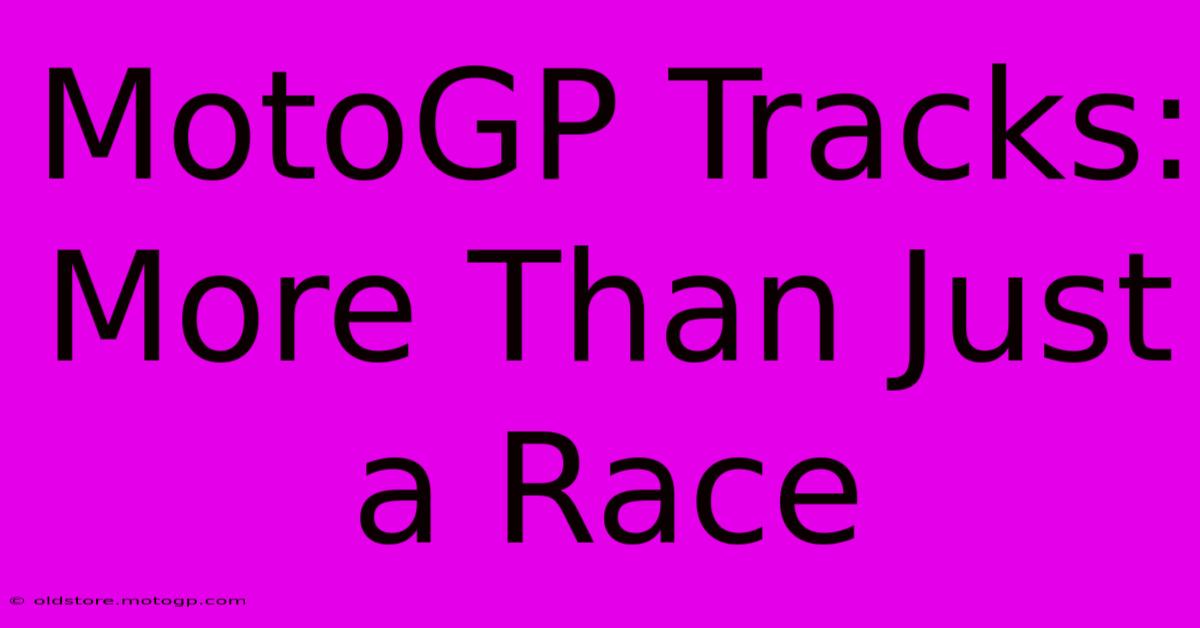MotoGP Tracks: More Than Just A Race

Table of Contents
MotoGP Tracks: More Than Just a Race
MotoGP. The name conjures images of screaming engines, breathtaking speeds, and nail-biting finishes. But beyond the thrilling spectacle of the race itself lies a world of fascinating detail surrounding the tracks where these legendary battles unfold. These aren't just asphalt ribbons; they're meticulously designed circuits, each possessing a unique character and history that significantly impacts the race outcome. This article delves into what makes MotoGP tracks so much more than just a place to race.
The Anatomy of a MotoGP Track: More Than Meets the Eye
A MotoGP track isn't simply a paved loop. It's a complex engineering marvel, carefully planned and constructed to deliver a thrilling and safe racing experience. Several key elements contribute to the overall character of each track:
1. Track Layout and Design:
The layout dictates the rhythm of the race. Tracks featuring long straights favor powerful bikes and top speed, while those with numerous tight corners reward precision and agility. Consider the classic tracks like Assen's flowing layout or the challenging twists and turns of the Red Bull Ring. The design elements – elevation changes, blind corners, and camber – all play a significant role in shaping the race strategy and rider performance. Each corner presents its own challenges, demanding different riding techniques and bike setups.
2. Surface and Grip:
The track surface is crucial. The grip levels vary significantly depending on the type of asphalt, its age, and weather conditions. A grippy surface allows riders to push their machines harder, while a slippery track demands caution and precision. Changes in surface texture throughout the circuit can also create strategic opportunities or challenges.
3. Run-off Areas and Safety Features:
Safety is paramount in MotoGP. Modern tracks incorporate expansive run-off areas, gravel traps, and air fences to mitigate the risk of accidents. The design and placement of these safety features are constantly reviewed and improved based on data analysis and safety advancements. These features are not just a passive element; they directly influence rider confidence and the overall racing intensity.
Beyond the Asphalt: The Cultural and Historical Significance
MotoGP tracks are more than just racing venues; they’re often steeped in rich history and local culture.
Iconic Tracks and Their Legacy:
Many tracks boast decades of racing heritage, witnessing legendary battles and pivotal moments in motorsport history. The legendary Isle of Man TT course, for example, stands as a testament to the enduring spirit of motorcycle racing. These tracks aren't merely race locations; they’re living monuments to the sport's evolution and the courageous riders who have conquered them. The history of a track often influences the atmosphere and the passionate fanbase associated with it.
The Impact on Surrounding Communities:
MotoGP races often bring significant economic benefits to host communities. The influx of tourists, media attention, and associated businesses contribute positively to the local economy. However, it also creates a unique bond between the track, the community, and the global motorsport fanbase.
The Future of MotoGP Tracks: Sustainability and Innovation
The future of MotoGP tracks will undoubtedly see an increasing focus on sustainability and innovation.
Environmental Considerations:
There is a growing emphasis on minimizing the environmental impact of track construction and operation. This includes exploring eco-friendly materials, reducing energy consumption, and implementing waste management programs.
Technological Advancements:
Technological advancements are being incorporated into track designs to improve safety, enhance the racing experience, and gather data for performance analysis. This might include advanced sensor systems, improved lighting, and augmented reality applications.
In conclusion, MotoGP tracks are far more than just venues for thrilling races. They are intricate pieces of engineering, steeped in history, and vital to the economic and cultural fabric of the communities they serve. Understanding their design, safety features, and historical significance adds a whole new layer of appreciation for the sport and the amazing feats of athleticism they witness. The future promises exciting developments in terms of sustainability and technology, ensuring these iconic circuits continue to evolve and enthrall for generations to come.

Thank you for visiting our website wich cover about MotoGP Tracks: More Than Just A Race. We hope the information provided has been useful to you. Feel free to contact us if you have any questions or need further assistance. See you next time and dont miss to bookmark.
Featured Posts
-
Sprint Race Results The Best Moments Caught On Camera
Feb 21, 2025
-
Lot F Your Gateway To The Best Of Circuit Of The Americas
Feb 21, 2025
-
The Price Of Glory The Sacrifices Of The Best Moto Gp Riders
Feb 21, 2025
-
Moto Gp Points System A Visual Guide
Feb 21, 2025
-
Cota Grounds Pass Immerse Yourself In The Atmosphere
Feb 21, 2025
